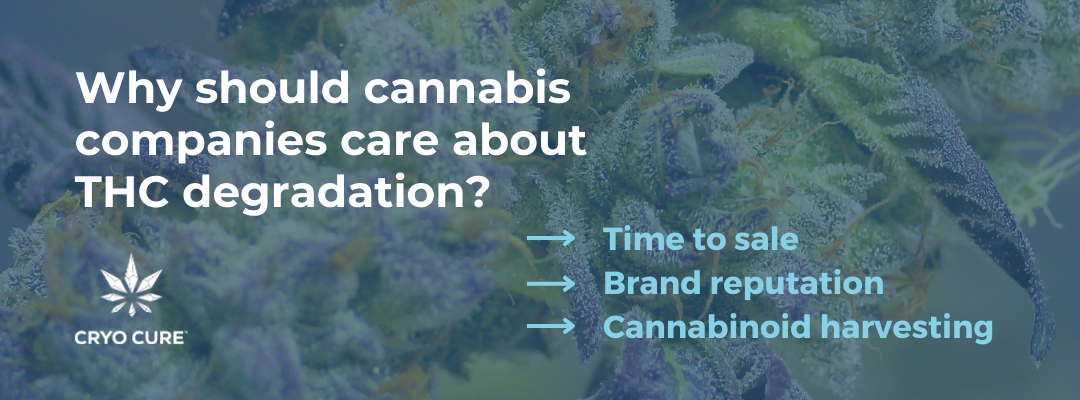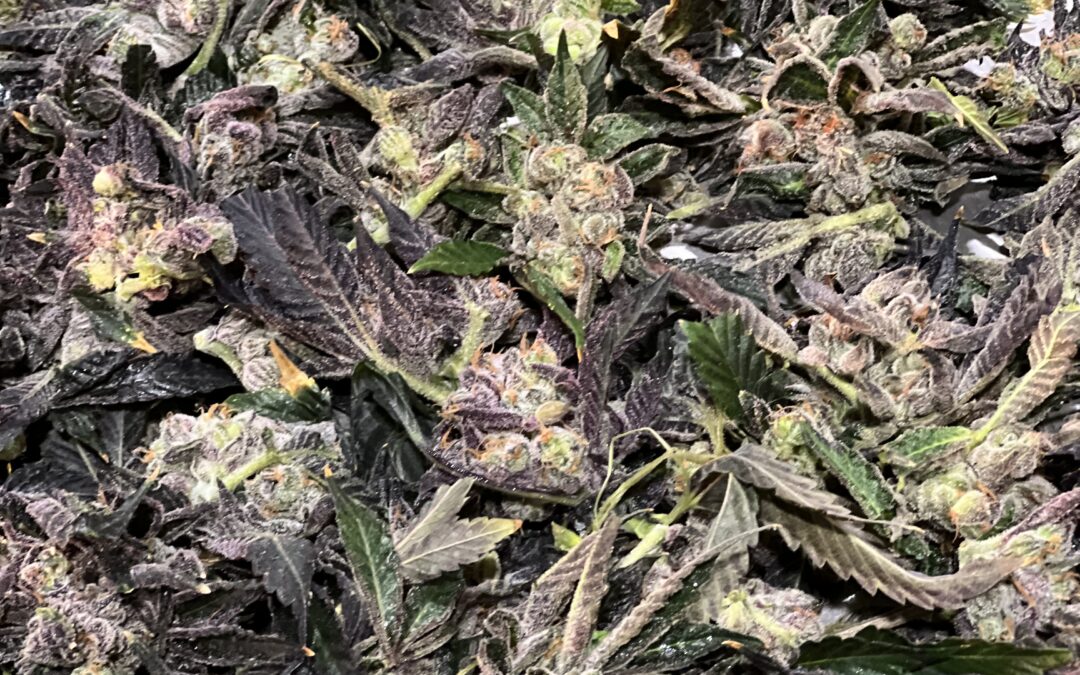You may have noticed that older or improperly stored cannabis is not as potent and fragrant as a fresh purchase. That’s because cannabis drying and curing doesn’t stop the many processes that cause Tetrahydrocannabinol (THC) to break down, called THC degradation. What is THC degradation, what speeds it up, and most importantly, is there a way to stop it?
What is THC degradation?
THC degradation refers to the reduced quality and quantity of THC in your cannabis flower. You may assume that THC degradation is an indicator that your flower is “bad” or it wasn’t grown in optimal conditions, but that’s no the case. It’s a natural and expected process once cannabis is harvested, one that continues even as cannabis dries, cures, and makes its way to the dispensary.
What is CBN and how does it connect to THC degradation?
Unlike terpenes, THC doesn’t evaporate when it degrades. It transforms into another phytocannabinoid altogether, called Cannabinol (CBN). CBN is known for its relaxing properties. It’s theorized that CBN is responsible for causing what you may have heard called the “couch lock” effect when your high is not an energetic one, but a deeply sedating one. Unsurprisingly, CBN is being explored by researchers for its potential as a sleep aid.
How can you tell if THC has degraded?
Take a close look at your bud next time you go to grind it up. Notice the white-ish coating on the outside of the bud. Those are trichomes, which are near-microscopic structures that house the majority of your flower’s phytocannabinoid content — including THC — and its terpene content. When the trichomes are milky white, that’s a sign that they are rich in THC. If the trichomes have turned from milky white to golden amber, that’s a sign that THC degradation is significant and CBN is now present in high amounts. If you’re still in doubt, smoke a little bit and see how you feel. If the effect is not as strong as you typically expect it to be, or if you feel a little sleepier than normal after consuming, it’s likely that THC degradation has occurred.
When does THC degradation begin?
THC degradation begins at harvest. The moment cannabis flower no longer draws nutrients from the roots, the THC destabilizes and begins to turn into CBN. This is also related to the disruption of something called the cannabinoid biosynthetic pathways, which is the process during which phytocannabinoids and terpenes transform into other compounds.
What accelerates THC degradation to CBN?
Even if you store your cannabis flower perfectly, the THC content will eventually degrade into CBN. It’s an unavoidable process, but it can be slowed through proper management of four environmental factors: temperature, humidity, air, and light. Here’s how each factor influences THC degradation.
THC degradation and temperature
Cannabis needs to be dried, cured, and stored at ideal temperatures to prevent THC degradation (and for terpene preservation). That’s because THC begins to decarboxylate at high temperatures. This process converts THC-A, or the acidic, non-intoxicating form of THC found in cannabis flower – into the intoxicating THC.
Heating your cannabis in a vaporizer or by lighting a joint kick-starts this process, which is how the temperature threshold is much lower than a flame’s. Cannabis flower only needs to be exposed to temperatures around 110°F for 30 minutes for decarboxylation to kick in and THC to begin degrading.
THC degradation and humidity
After putting all that time and work into drying your cannabis flower, it’s no surprise to learn that introducing humidity back into the plant can be harmful to its quality. Drying and curing cannabis flower to the right humidity levels is crucial for stabilizing THC content. However, it’s important that flower isn’t too dry – extracting too much moisture can make the flower too brittle and crumbly to consume.
THC degradation and air
Air may seem harmless, but oxygen is one of the most significant contributors to THC degradation. Cannabis exposed to oxygen will degrade faster than it would in other environments. High levels of CBN can indicate that the cannabis was exposed to too much oxygen during the drying and curing process, or it may be an indicator that the cannabis was improperly stored.
THC degradation and light
Exposure to light, specifically UV rays, contributes to THC degradation. These rays contribute to the breakdown of organic matter, including plant matter like cannabis. That’s why it’s so important to store your cannabis in dark places where they won’t be exposed to sunlight.
Why should cannabis companies care about THC degradation?
Certainly, cannabis needs to be stored correctly at home – away from light, oxygen, and humidity at the correct temperatures – to extend its longevity. But THC degradation should be a concern for dispensaries and other cannabis purveyors, too. Here’s why cannabis companies need to be concerned about THC degradation:
- Time to sale: The longer cannabis sits unsold, the more time THC has to degrade into CBN. This limits flower’s ideal freshness window, and in turn, how long product can sit on the dispensary shelf before flower is no longer of quality.
- Brand reputation: Stale flower or old flower can earn a brand a bad rap. Although there’s nothing to do to stop time, it is in a brand’s interest to preserve freshness as best as they can to ensure a positive experience once the customer takes it home.
- Cannabinoid harvesting: For extractors and manufacturers of infused products, maximizing THC extract is of utmost importance. Flower that’s been exposed to higher temperatures, non-ideal humidity levels, oxygen, and UV rays will degrade into CBN faster, producing a smaller yield of THC content.

How Cryo Cure prevents THC degradation
Cryo Cure is celebrated for its “feast of the senses,” preserving cannabis flower’s color and aroma as if the flower was just picked from the plant. Those same patent-pending preservation techniques take hold on the molecular level, resulting in a euphoric experience without the “couch lock” effect.
As we discussed earlier in this article, time is the enemy of fresh cannabis, and THC degradation begins the moment the flower comes off the plant. Cryo Cure’s patent-pending technology trims down time spent drying and curing cannabis from weeks to as little as 13 hours, shaving THC-killing time off a lengthy process. Cutting down this time preserves the THC-A content of the plant, preventing it from degrading into THC and eventually CBN before the product even makes it to the shelf.
Additionally, Cryo Cure’s drying and curing process is conducted at subzero temperatures. This freeze drying technique means that too-high temperatures aren’t even a possibility in the Cryo Cure process. Cryo Cure machines are also tuned for ideal moisture levels in cannabis flower, around 8 to 12 percent, so too-high humidity levels won’t be a factor, either.
Cryo Cure prevents THC degradation
Drying and curing cannabis are essential processes for preserving your flower for the long haul, but they fail to capture the plant at just-harvested freshness levels. Even if you dry, cure and store cannabis properly and perfectly, THC degradation will begin the moment the plant is harvested. The question is not if you can prevent THC degradation altogether, but how you can slow down the process. Storing cannabis away from light and oxygen at the right temperature and humidity levels can extend the life of your flower’s THC content, or you can opt for Cryo Cure, which mitigates the major actors that accelerate THC degradation in the first place.



